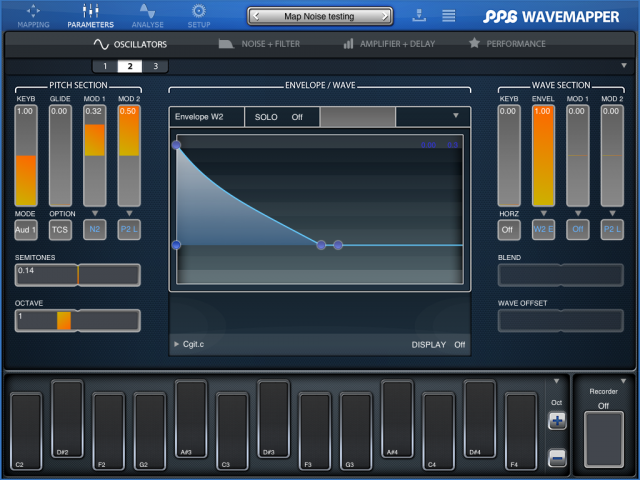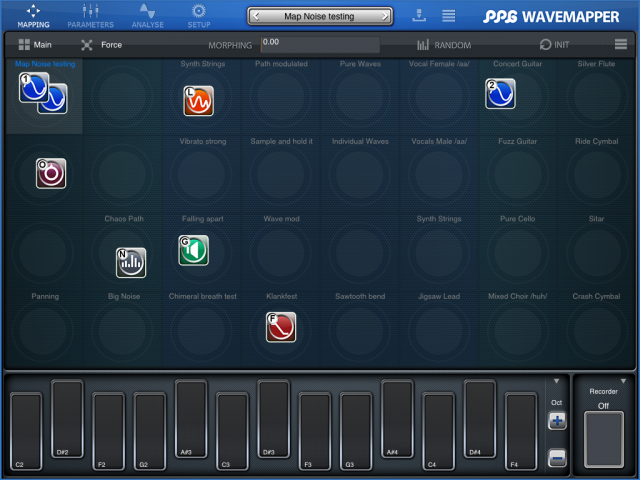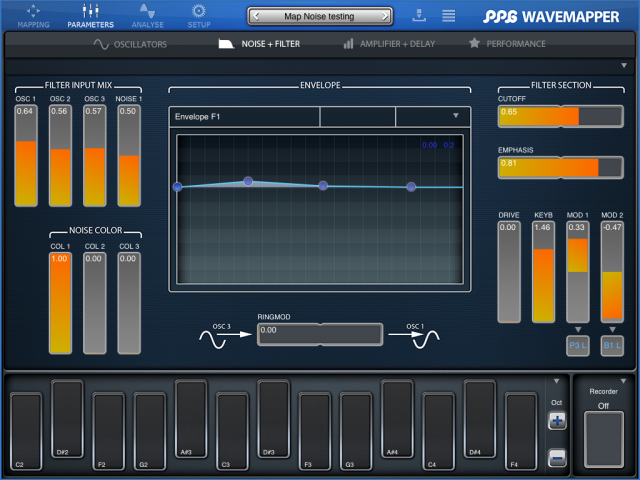Synth pioneer Wolfgang Palm has introduced a new software synthesizer for iOS, PPG WaveMapper.
PPG WaveMapper expands on Palm’s work with wavetables and introduces a new synthesis system, which can be seen as a bridge between wavetables and samples. In wavetable systems you have great flexibility in controlling the sound, but sound material is limited to harmonic, noise-free waveforms. On the other hand there are samplers, which have very high sound quality, but very limited editing features.
In WaveMapper there is a new type, the “time corrected sample” (TCS). This can reproduce a much wider palette of sounds then classic wavetables, but still allows for a total control, for example with an envelope or LFO.
‘It is a completely different way of programming sounds,” Palm says. “You do not start with a lot of detailed setting, but with a combined set of parameters which you can select with the touch and swipe of a finger. And the combination of those parameters belonging to a Module make sense of course, it gives the user (being experienced or not) a very fast way for creating unique sounds.”
Here are the details:
PPG WaveMapper
The Mapping window is the visualization of a pool of programs on which “modules” float. Those modules represent parameters of the synthesizer engine and each module can be placed on one of 32 programs. The moment an item is placed on map then the parameters of that module will take on the settings of those parameters in the underlying program on the Mapping window.
At a basic level, you can use this mapping technology as a starting point to create complex sounds. For example you can drag a string sound source onto a drum envelope, or a guitar sound onto a string envelope. Power users can delve deeper into the back end of any sound, using a full set of professional features.
Here are the official audio demos:
[soundcloud url=”http://api.soundcloud.com/playlists/2380151″ params=”” width=” 100%” height=”150″ iframe=”true” /]Features:
- New Sound map concept – create new sounds playful and experimental
- 3 types of synthesis – the optimal type for kind of each sounds
- Classic wavetables – for the typical PPG sounds
- Time compressed samples – more authentic sounds, allowing analysis of
user samples - Pure samples – classic sample playback
- Analyzer – convert your own samples into the new format or into
wavetables - 3 oscillators capable for totally independent sound sources
- 90 sound resources – a huge sound palette, from real instruments to
abstract wavetables - 4 parameter editor pages – comfortable and detailed access to all the
parameters - 3 Noise generators, for audio and modulations
- Classic 24 dB Lowpass Filter, combined with an overdrive simulation.
- Dual amplifier, for versatile control of 2 audio signals as well as panning.
- 13 Envelopes, for independent control of pitch, waveform, filter and noise
gain and panning - 4 LFOs – with 5 waveforms
- Delay/Reverb effect
- Flexible Step Sequencer / Arpeggiator combination
- Schematic touch keyboard – Build your own keyboard, with the keys you prefer for your music.
- Powerful sound browser – sorting by category, bank management
- Virtual and Hard-MIDI in/out – sending/receiving keys and controllers.
- Audiobus support.
- 10 min audio recording and Audio copy.
PPG WaveMapper is available in the App Store, priced at $19.99.




It is intriguing. I’m having a hard time getting an idea what it does from this description. The audio demo on the website only gives a little taste. I’ll look forward to a more detailed walk-through video.
Sick, I can’t wait!!!
I’ll wait until PPG Wave gets some UI fixes and usability updates (tiny keys!! ) before spending another 20$.
yep totally
I fully support Palm’s ideas for iPad apps.
I received the email and am quite exited to try it out. It will be downloaded the day it hits.
It look unique. Good times for iPad owners!
Thanks
No audiobus? Looks good, but I’m only buying audiobus enabled apps from now on, especially as cubasis is going down he audiobus route 🙂
i’m really stoked about this.
i know people area really into audiobus, but i feel that its implementation has created some problems for the synths that are using it (nlog and animoog have both experiences crashing problems for me since the update with audiobus). i assume that these will be worked out eventually, but audiobus is not a deal breaker/maker for me.
Hi,
AudioBus is of course a complex piece of software, not only the AudioBus app itself and the sdk you implement in your apps, but also the integration work. Since I was involved in testing the SDK I can assure you the Michael & Sebastian did a great work of keeping it as simple as possible and made it very stable. However, you cannot test all in advance, there too many use cases people now using AudioBus. Your app is now running with whatever app in parallel and connected. With NLog I was in the first row of adopters and I have implemented all three roles: Input, Filter & Output. So, I released last night an update with a fix for the problem mentioned. We knew there will be a learning curve once AudioBus is in the wild, so the only chance is to go through it and fix and improve what’s needed. That’s our promise. If there’s a problem, please contact the app developer. And if you have ideas how to improve, tell them too. I know that Michael & Sebastian have many ideas. So, Kudos to them! We all do our best and work hard.
Cheers
Rolf
PS: To be correct, the iPad PRO version of NLog has been updated last night, the iPhone version is still in review, but should be out soon.
yes. and i have the new update, which seems to work better.
so a *big* thanks for that.
for what it’s worth, i contacted rolf and he was really great in fixing this problem (and i hope i was of some help). one of the great things about small developers (meaning not people like korg, etc.) is the sense of community one has as a user with the developer. kinda great, imho.
hopefully people understand that i’m not trying to say anything bad about anyone concerned, i’m just pointing out that there have been problems.
i know it’s complicated—which i guess is part of why i don’t think it’s the end-all that others seem to think it is . . . as least not yet.
Damn… Audiobus not a deal breaker? You don’t like to play along with and record in sync to other tracks? Audio bus allows you to record like using a daw finally. I guess if you’re just playing live it doesn’t matter….
for what i do at this moment, no.
in the future, maybe.
i’m intrigued that someone dislike an opinion or personal need based on working process. geez, get a grip.
that would be thumbs-down guy. He’s here to provide some balance and very rarely misses a post. I sometimes suspect that he’s on the payroll. He maybe even be a ghost in the machine.
haha. okay.
at least he has a life.
Excited to see this evolution of the technology Wolfgang created for Plex.
I’m a Wolfgang fanboy at this point. I’m excited for this. I’m also on board with the idea of bridging the gap between synth and sampler, if Wolfgang is doing it, there’s not really that many other people I’d want for the job. He’s a very involved app developer and he makes good stuff.
I hope we get some UX changes along with this : full screen keyboard , TC-11 like plain playing area , better preview pane , options to hide controls or show less. A “performance” mode will be welcome that can get most of the knobs and sliders out of the way.
I guess many people keep going back to animoog is because there are less number of tweakable parameters that distract or get your focus away from actual playing ….and those awesome keys !!!
while the size of the keys on the ppg is annoying, what you can do with them is great. but, yeah, it would nice to have a full-screen option. and tc-11 is the bomb, so i’m with you on that (though i wish he would do one more osc).
and a real hold button would be great.
Maybe it’s time to get away from every iOS synth developer reinventing the keyboard.
With MIDI and AudioBus, iOS synths can be more like VST’s. there’s not much value in developers tacking on a ‘virtual keyboard’ to a synth – only when they do something innovative like Animoog’s keyboard.
I loved his first iPad app and this one looks great, but why the hell not do them as VST’s as well? I know I might be in the minority but I still find integrating an iPad synth into my workflow to be a pain. If he did these as VST’s I could just drop it right in and start using it right away.
The app is audiobus compliant, go ask wolfgang
According to the specs published ion the Ap’s website, it is Audiobus compliant…
Here is a cut and paste of the relevant section….
“….Powerful sound browser – sorting by category, bank management
Virtual and Hard-MIDI in/out – sending/receiving keys and controllers.
Audiobus support.
10 min audio recording and Audio copy…..”
I guess this was accidentally left of the specs posted here…
Thanks for the feedback. The stats may still be in flux, but I added the new items.
Hi Guys
The new WaveMapper app does include audiobus support.
We also want to underline that development for WaveGenerator is still ongoing with more to come, so rest assured new features and fixes will continue to come for that baby.
Thanks for your interest in Wolfgang’s lastest synth.
Yet another reason for me to buy an iPad